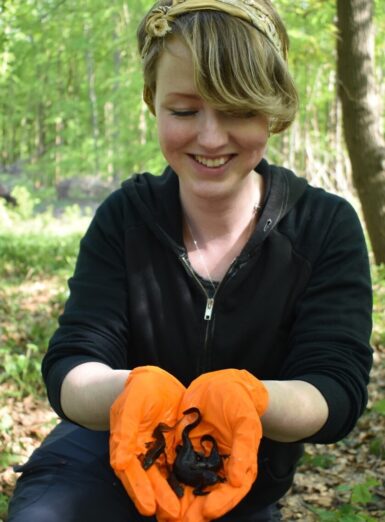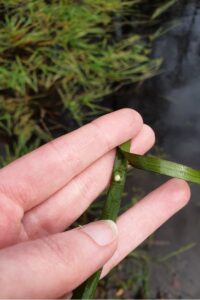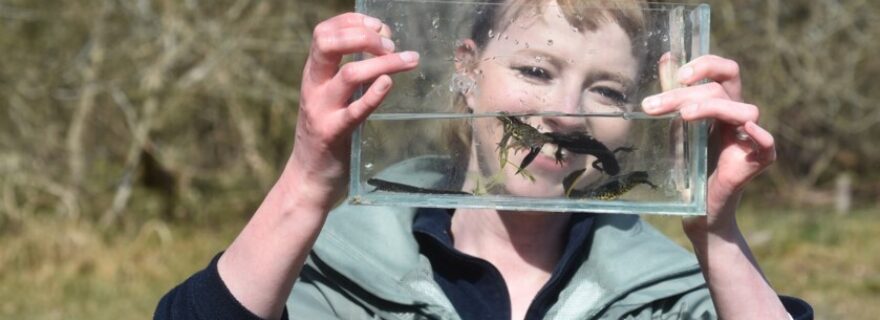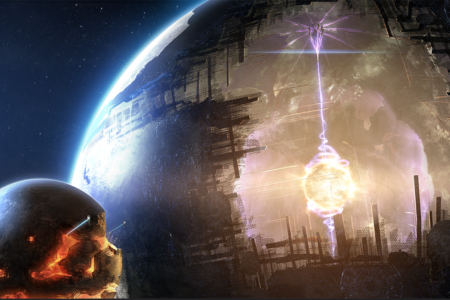The tragedy of Triturus
During the course Popular Science Writing, students are asked to write an article based on a scientific talk, a practice that is close to our hearts. This week, an article about an eccentric newt, written by Dana Lefèbvre.
It’s spring. A newt of the genus Triturus emerges from underneath a tree trunk to start mating season. In the water she meets a male with a large comb on his back. It moves up and down with the current and waves its pheromones towards her, hoping for her to fall for him. The masculinity is overwhelming and she takes in the sperm package that the male dropped. Carefully, she places hundreds of eggs one by one between the leaves of aquatic plants and patiently pinches them closed with her hind legs for a long time. It’s a meticulous process that takes weeks to finish. And even after all this effort, only half of the eggs will hatch.


Survival of the failure
For a long time scientists have wondered why only a fraction of the laid Triturus-eggs actually hatch. An evolutionary defect seems to be the cause. The DNA of Triturus is full of mistakes. There are two versions of the mistakes: the first version on one of the chromosomes masks the other version on the other chromosome and the other way around. Both mistakes are needed for a healthy egg. You can compare it to making a rainbow. If only the sun is shining, you won’t get a rainbow. If it’s just raining, you won’t see a rainbow either. A rainbow only forms because of a combination of rain and sun rays.


It is puzzling how these errors have evolved over time. There are nine Triturus-species, and each species only sees half of their eggs hatch. It’s highly likely the condition occurred in the common ancestor.
In the nineteenth century, Charles Darwin wrote about the survival of the fittest in his book On the Origin of Species. Here he states that the species who are adapted the best to their surroundings will survive. But it doesn’t sound very well-adapted, a species of which half of the offspring dies before they can even leave the egg. At least, that’s what most people would agree on. But then how did the great crested newt evolve with this structural error?
Fatal supergene
Is it this question that Manon De Visser, PhD candidate at Naturalis Biodiversity Center and the Institute of Biology Leiden, is trying to solve. “For my PhD I am — together with my colleagues of the Wielstra lab — seeking to understand how DNA of eggs directs their survival; which genes are broken, and which genes are expressed?” Answering these questions is a painstaking endeavor. Newts possess an enormous quantity of DNA. “If you were to write out the DNA of one newt in phone books, you would need well over 2000 books. For one human you would need a little over 200 books”, says De Visser. To efficiently find errors within all this genetic material, it is necessary to shred the DNA in small pieces, and examining the individuals fragments.
De Visser’s hard work is paying off. The theory it’s trying to prove was conceptualized by Dr. Ben Wielstra and has everything to do with so called supergenes. De Visser explains: “A supergene is a short DNA-sequence carrying multiple genes that are inherited as one block. The Triturus-eggs that have both versions of the mistakes, both survive ánd get more benefits in the first place because of these supergenes.”
There are two forms of the supergene that don’t exchange DNA, even though this is the way to filter out mistakes. Because there are barely any combinations between the different supergenes in this case, new mistakes aren’t able to disappear after some time, causing them to become more damaging for newts with two of the same versions of the mistakes. This ultimately became fatal. “I always compare it to Greek mythology. King Midas was greedy and wanted to make everything he touched turn to gold. It seemed beneficial, but in the long run it became lethal.
Unknown
This tragedy doesn’t just affect Triturus-newts. Some plants and insects have also been shown to suffer from this phenomenon. Dr. Wielstra presumes the syndrome is easily overlooked by biologists, and could also exist in many other species. The research Wielstra's lab presents us with beautiful insights about supergenes, many of which can be applied to other species of living things.
In the end, their goal isn’t to “help” these newts. Triturus has survived with this syndrome for millions of years and — along the way — has seen the rise of nine species. Next spring, the great crested newt will emerge again from under the tree trunks to carefully wraps her eggs one by one, completely oblivious to the reality half her offspring will never see the light of day.
- Read more: De Visser, M. C., France, J., Meilink, W. R. M., & Wielstra, B. (2021). An evolutionary mystery: the deadly chromosome 1 syndrome in Triturus newts. RAVON, 23(1), 9–12.






0 Comments
Add a comment